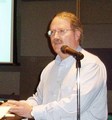Delta Embraces Green Infrastructure to Resolve Problems and Create Amenities
Delta has completed numerous examples of rain gardens and infiltration swales on public rights-of-way. Delta's experience illustrates the benefits of landscape-based solutions to solve drainage issues and create community amenities.
STORMWATER PLANNING: A GUIDEBOOK FOR BRITISH COLUMBIA – “The Guidebook also introduced the concept of performance targets to facilitate implementation of the integrated strategy for managing the complete rainfall spectrum,” stated Kim Stephens, Guidebook project manager & principal author

“The goal of adaptive management is to learn from experience and constantly improve land development and rainwater management practices over time,” stated Kim Stephens. “The Guidebook introduced two innovations that are inter-linked with each other and with an adaptive management approach. The first was the concept of an integrated strategy for managing all the ‘rainfall-days’ that occur each year. The Guidebook also introduced the concept of performance targets managing the complete rainfall spectrum.”
LOOK AT RAINFALL DIFFERENTLY: British Columbia’s ‘Beyond the Guidebook Initiative’ introduced at 2007 Annual BCWWA Conference – “To accommodate the requirement to maintain stream health, advances in analysis techniques have led to a system that provides a quantitative analysis of both the potential erosion and the availability of aquatic habitat,” stated Jim Dumont

The key message is that Beyond the Guidebook 2007 was the first guidance document to connects the dots between the Water Balance Methodology and stream health protection. This breakthrough was transformational because it allowed drainage practitioners to develop a watershed approach that addresses stream protection and/or restoration. “We have been able to optimize the designs of mitigation works to both reduce the costs and to increase their effectiveness. In this manner we have gone Beyond the Guidebook in a rational and logical manner to reduce the total system requirements and cost,” stated Jim Dumont.
Making the Connection Between Rainwater Management and Stream Health at the Annual BCWWA Conference

“Beyond the Guidebook will take the Guidebook innovation to the next level of evolution. Now that practitioners are becoming comfortable with what ‘rainfall capture’ means in practice, local governments and the development community are in a position to turn their attention to what is an achievable outcome that makes sense and results in a net environmental benefit,” stated Kim Stephens.
APEGBC Sponsors Province-Wide Drainage Seminars that Complement "Beyond the Guidebook"

“There is a need for a new approach to hydrologic design. A key message is that a rainfall-based approach does not work effectively. This is why I advocate a runoff-based approach. Duration of discharge is important because it links directly to stream health. The ‘runoff-based approach’ holds the key to assessing environmental impacts in watercourses and the effectiveness of mitigation techniques”, stated Jim Dumont.
BEYOND THE GUIDEBOOK INITIATIVE IN BRITISH COLUMBIA: At 2007 Water Balance Model Partners Forum, Jim Dumont explained why and how the Runoff-Based Approach connects the dots between on-site rainwater capture and downstream stream health

“A basic tenet of hydrology is that rainfall and runoff have different return periods. Yet drainage practitioners persist in applying a rainfall-based approach that assumes rainfall will always result in the same magnitude of runoff,” stated Jim Dumont. “We are at a crossroad in the path defining the methodologies and applications used in rainwater management. In a nutshell, Beyond the Guidebook enables us to make a clear distinction between a rainfall-based approach and a runoff-based approach. The runoff-based approach is best suited to the analysis needed to assess effectiveness of mitigation techniques.”
City of Portland Coins RAIN Acronym as an Alternative to 'Stormwater' Management

“Most communities have developed in similar ways regardless of climate. Design principles have facilitated swift conveyance of stormwater and the pollutants it carries into receiving waters. This practice and other unfortunate consequences of past design must change,” says Tom Liptan.
Inter-Governmental Partnership Rolls Out ‘Beyond the Guidebook’ at Water Balance Model Forum

“Beyond the Guidebook will take the Guidebook innovation to the next level of evolution”, stated Kim Stephens. “Now that practitioners are becoming comfortable with what ‘rainfall capture’ means in practice, local governments and the development community are in a position to turn their attention to what is an achievable outcome that makes sense and results in a net environmental benefit.”
Story of the UBC Tree Canopy Interception Research Project

“The project is precedent-setting, both in terms of the research scope and the coalition of funders. The Province of British Columbia, the Greater Vancouver Regional District, and the Real Estate Foundation of British Columbia funded the project start-up. When the University of British Columbia recently obtained a research grant from the Canadian Water Network, this brought a national focus to the project,” stated Kim Stephens. While considerable research has been undertaken in forest stands in the natural environment, very little has been done in an urban setting anywhere in North America.
City of Nanaimo Hosts Water Balance Model Session on 'Sustainable Drainage'

Seek to Understand, City of Nanaimo (Feb 2007)
KAS
In February 2007, the City of Nanaimo hosted a session in order to learn more about what other local governments are doing to implement 'sustainable drainage'.

